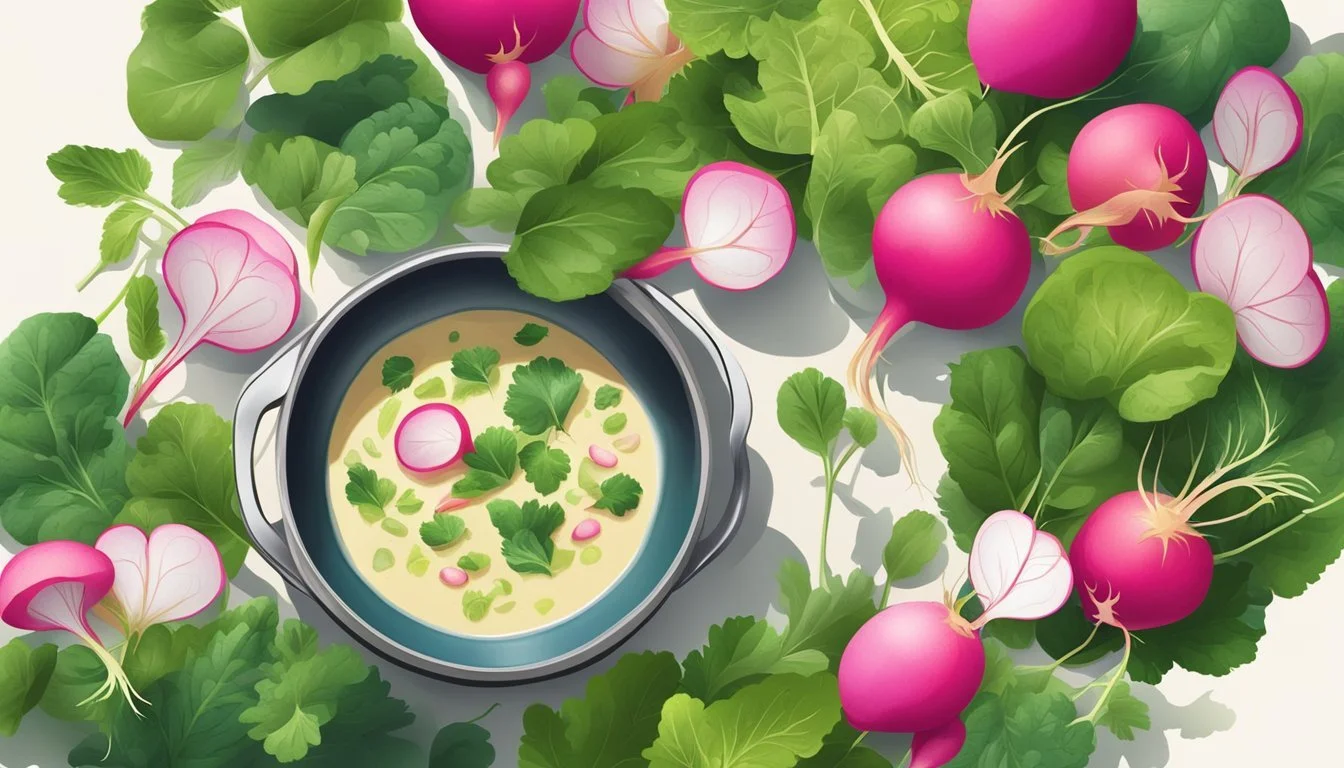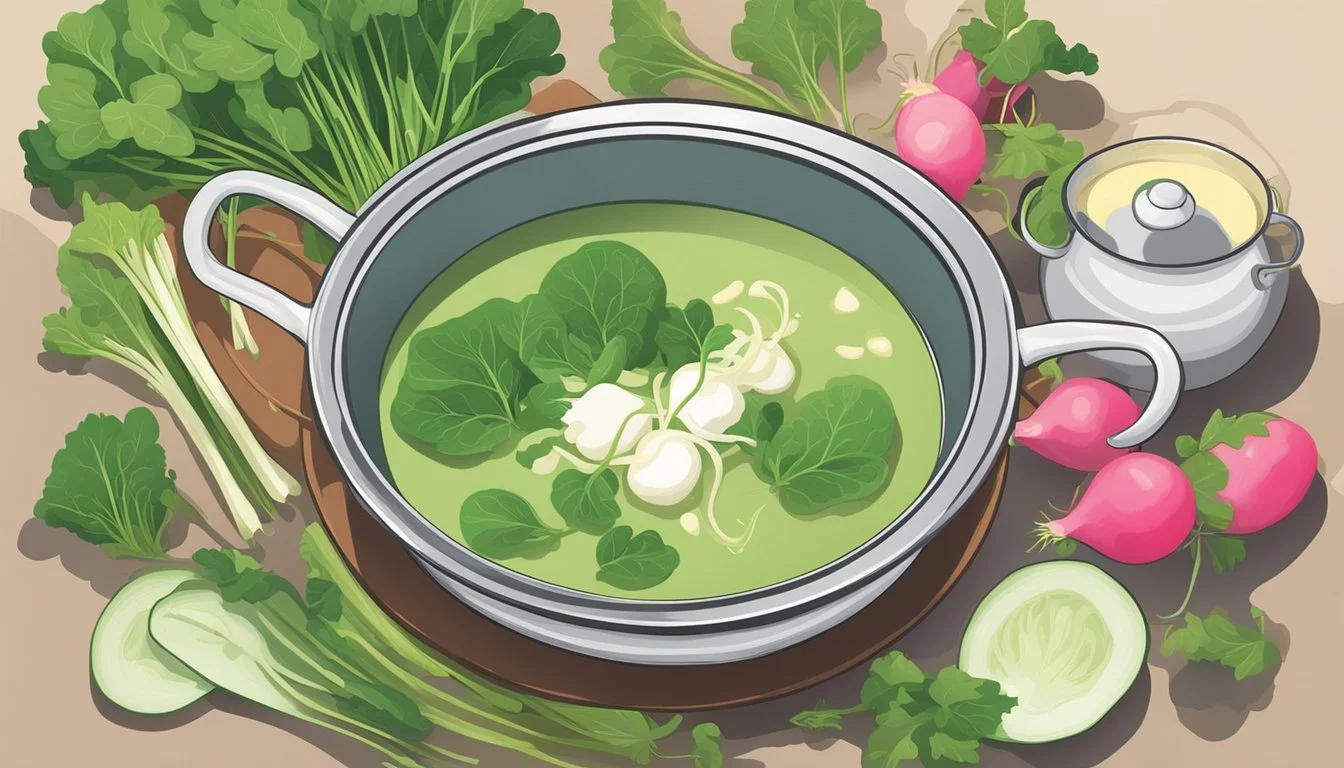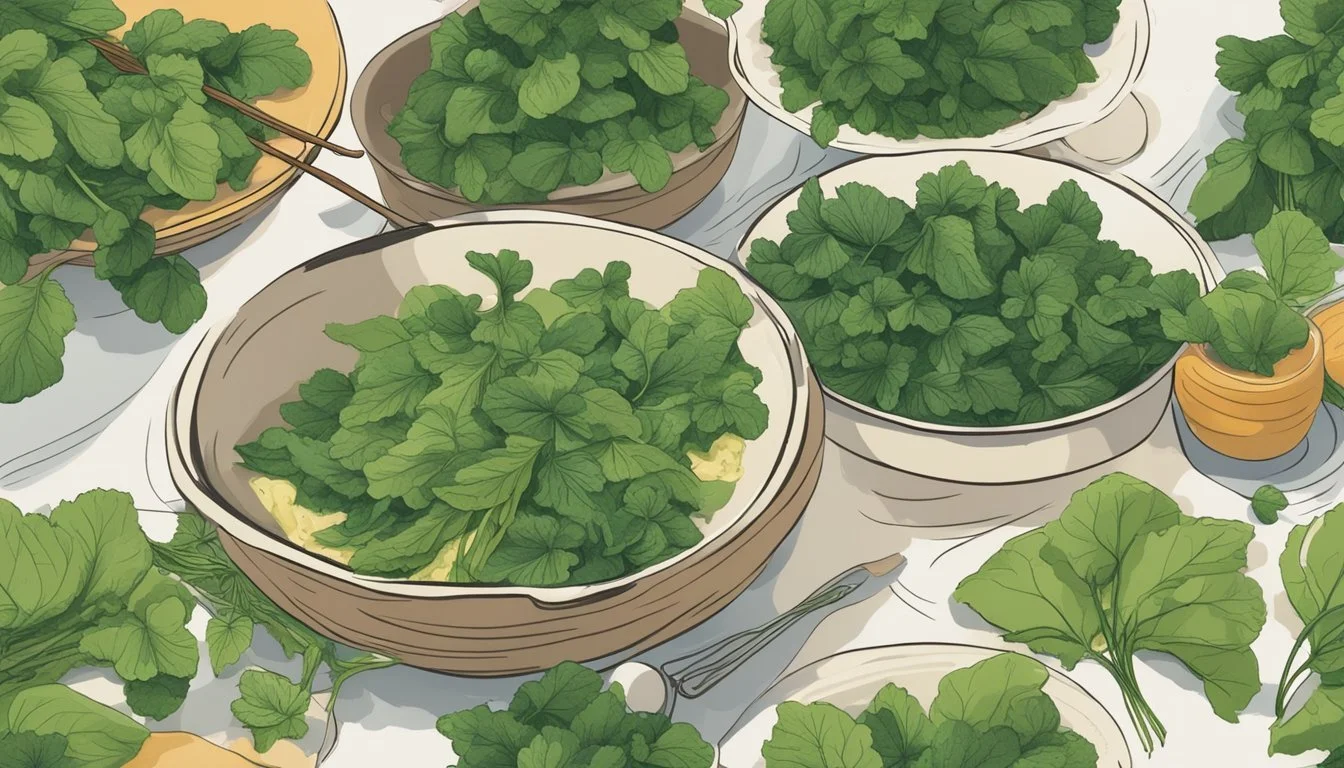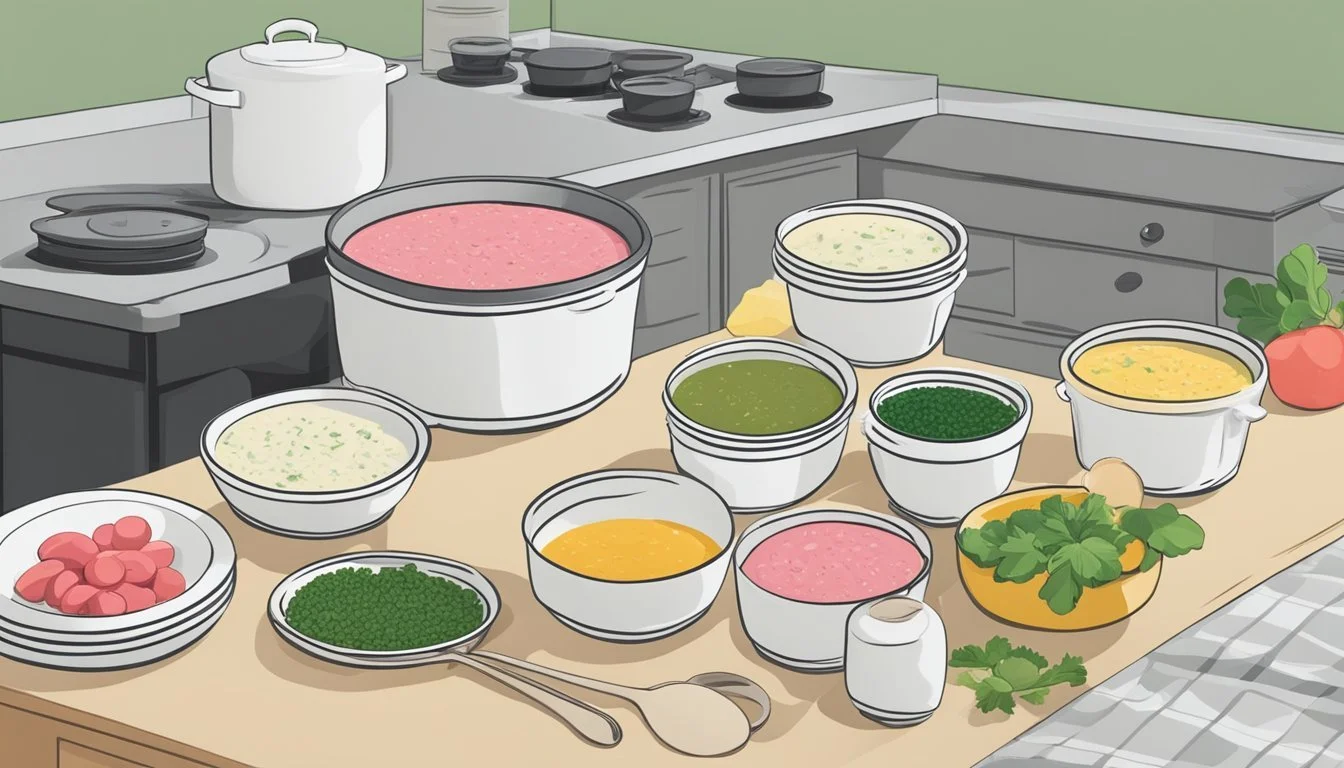Radish Leaf Soup
A Peppery, Creamy Starter Unveiled
Radish leaf soup is a culinary revelation that repurposes the often-overlooked tops of radishes into a flavorful, nutrient-rich dish. This soup, hailing from various culinary traditions, brings a peppery twist to traditional greens soups (What wine goes well with soups?). Its creamy texture contrasts with the slight spicy kick of the radish leaves, making it a distinctive starter that captivates the palate and enlivens the senses.
The preparation of radish leaf soup is a lesson in resourcefulness and simplicity. Combining basic ingredients such as butter, onions, and potatoes with the fresh zest of radish leaves, this dish transforms simple vegetables into a complex flavor experience. Cooks prize it for its versatility, as it can be served hot or cold, and it often includes embellishments like a dollop of crème fraîche or a sprinkle of fresh herbs to elevate the dish further.
Nutritionally, radish leaves are a powerhouse, packed with vitamins and minerals. Incorporating these leaves into a soup not only reduces food waste but also provides a healthy boost. As individuals become more environmentally conscious and look to sustainable eating practices, radish leaf soup stands out as a choice that supports a no-waste kitchen while delivering an exquisite taste profile suitable for a variety of dining occasions.
Radish Leaf Soup Origins
Radish Leaf Soup, a traditional French dish particularly relished in spring, stands as a testament to the resourcefulness of regional cuisines that emphasize both health and flavor. This soup transforms a commonly discarded ingredient into a delectable course.
Historical Context
Historically, radish leaves were not seen as a staple for soups. However, the French, known for their no-waste approach to food, found a way to utilize them. The exact origin of Radish Leaf Soup is not documented, but it's clear that frugality and the appreciation for every part of the plant was a driving force. During spring, when radishes are at their peak, the leaves are most tender and flavorful, making them perfect for a light, peppery soup.
Cultural Significance
The cultural significance of Radish Leaf Soup in France lies in its embodiment of the country's culinary ethos: a regard for seasonality and an aversion to waste. It represents a piece of French culinary wisdom that has been passed down through generations. Every spring, the revival of this soup on French tables highlights the ingenuity of home cooks who aim to create nutritious, flavorful dishes using all available resources. With the current emphasis on healthy eating, Radish Leaf Soup gains prominence for its use of fresh, seasonal ingredients, aligning with the values of modern cuisine while staying rooted in tradition.
Health Benefits and Nutritional Facts
In the culinary world, radish leaf soup emerges as not only a flavorful starter but also a nutritious choice packed with essential vitamins and minerals. Notably, the leaves—a part often discarded—are rich in beneficial nutrients.
Vitamins and Minerals in Radish Leaves
Radish leaves are a surprising source of vital nutrients. They are:
Rich in vitamin C: Important for immune function and skin health.
Contain calcium: Essential for bone strength.
Provide iron: Crucial for blood health.
One can optimize these benefits by selecting organic, unsprayed radish leaves, ensuring they are free from potentially harmful chemicals.
Benefits of Greens in Diet
Inclusion of greens like radish leaves in one's diet supports overall health. These greens offer:
Dietary fiber: Aids in digestion and supports gut health.
Potassium: Contributes to heart health.
Antioxidants: Help combat oxidative stress.
The dietary fiber present in radish leaves may provide approximately one gram per half cup, promoting satiety and supporting weight management. Regular consumption of greens can bolster a healthy and balanced diet.
Ingredient Spotlight
In creating a standout Radish Leaf Soup, the selection of radishes and the type of cream used can significantly influence the flavor profile and texture of the dish.
Radish Varieties and Selection
Radishes present more than a peppery punch; their variety impacts the soup's final taste. The best radishes for a Radish Leaf Soup are those with fresh, vibrant green leaves that indicate freshness and good health. The radish variety plays a role too, ranging from the common red and round Cherry Belle to the elongated and more pungent French Breakfast. Spring is the prime season for radishes, ensuring a tender and flavorful leaf, which is a cornerstone ingredient in this soup. While selecting radishes, look for:
Bright green leaves without yellow spots.
Firm, plump radishes for the most flavor.
A Closer Look at Cream and Alternatives
The creaminess of Radish Leaf Soup comes not just from dairy but from its plant-based substitutions as well. Heavy cream provides a rich texture and smooth flavor. For a tangier note, crème fraîche or sour cream can be used. These ingredients not only offer a creamy consistency but also introduce a subtle sharpness to the soup. Milk, while lighter, can still be an option for those seeking a less rich soup.
For a vegan alternative, coconut milk serves as a great substitute, adding a hint of sweetness and exotic flavor without the dairy. When using plant-based milk, it's important to balance the dish with a good quality olive oil that can provide the luxurious mouthfeel often associated with cream.
In the context of other ingredients, potatoes lend their starchy goodness to the texture of the soup, while the foundation flavor-builders like onion and garlic are essential for the base. One should not underestimate the power of a freshly ground black pepper, which can elevate the peppery notes of the radish leaves.
Preparation Essentials
Before starting the radish leaf soup, one must gather specific kitchen tools, understand the pre-cooking procedures, and know how to store the ingredients properly to maintain their freshness.
Kitchen Tools Required
For the smooth preparation of radish leaf soup, here is a list of the necessary kitchen tools:
Cutting board and knife: To trim and chop the radish leaves and other vegetables.
Large saucepan: Ideal for sautéing onions and simmering the soup.
Blender, immersion blender, or food processor: Essential for pureeing the soup to a creamy consistency once it's cooked.
Pre-cooking Procedures
Before cooking, the chef must:
Wash radish leaves thoroughly to remove any dirt or debris.
Chop ingredients uniformly so they cook evenly.
It's beneficial to measure out all spices and prepare broth beforehand to expedite the cooking process.
Storing Ingredients Properly
Proper storage of ingredients ensures freshness and quality. Use the following guidelines:
Radish leaves: Store unwashed in the refrigerator's crisper drawer, wrapped in a damp paper towel.
Produce: Keep vegetables in a cool, dry area of the kitchen or in the refrigerator.
Broth and cream: Refrigerate and make sure they're well-sealed.
For long-term storage, freezable ingredients can be kept in the freezer, with soup stored in airtight containers.
Cooking Methodology
The cooking process for Radish Leaf Soup involves creating a flavorful base that will support the delicate peppery notes of the greens, followed by a seamless integration of both greens and cream to achieve a smooth and rich consistency.
Soup Base Crafting
To lay the foundation for the soup, a soup base is essential. The base begins with sautéing onions in butter until tender, which typically takes about 5 minutes. Following the onions, cubed potatoes are added for their starchy quality that contributes to the soup's texture. Chicken stock or vegetable stock is then introduced to the mixture along with water to create a flavorful liquid the potatoes can simmer in. This will generally require 10-15 minutes until the potatoes are fork-tender.
Ingredients for Soup Base:
Butter
Onion
Cubed potatoes
Chicken or vegetable stock
Water
Salt (to taste)
Integrating Greens and Cream
After the soup base is ready, radish leaves, often discarded but full of flavor, are stirred into the pot. These greens should wilt and cook through without losing their vibrant color, which often takes a few minutes. The final touch is cream—whether milk, heavy cream, or a combination—which is carefully mixed in to lend the soup a luxurious and creamy mouthfeel. If additional thickening is needed, a roux made from butter and flour can be incorporated at this stage.
Steps for Integrating Greens and Cream:
Add radish leaves to the simmering base.
Pour in milk or heavy cream, adjusting based on desired richness.
Stir to combine, and simmer until greens are fully cooked.
This careful blending of base flavors with the peppery radish leaves and the rounded finish of cream exemplifies the culinary alchemy of Radish Leaf Soup.
Seasoning and Flavor Profiling
Crafting a memorable Radish Leaf Soup requires a delicate balance of seasoning and flavors. The choice of herbs and spices can elevate the soup from simple to sublime.
Herbs and Spices for Enhancing Taste
To enrich the soup's taste, one may consider a combination of salt and black pepper as foundational elements. These two basic seasonings work synergistically to heighten the natural flavors of the ingredients. Moreover, garlic cloves can be sautéed at the beginning to add depth, while a pinch of nutmeg offers a subtle warmth. For a unique twist, one could explore the addition of mustard or pesto, both of which can introduce a complex tanginess to the dish.
Salt: Essential for highlighting flavors.
Black Pepper: Adds a mild heat that complements the radish leaves.
Garlic Cloves: Contribute a savory note that's indispensable.
Nutmeg: Its warming quality can enhance the soup's comfort factor.
Mustard/Pesto: Can be added for a punchy, herbaceous lift.
Balancing Flavors
When tasting the soup, if one finds the flavor profile too bitter—partly due to the radish leaves—a bit of cream can be stirred in to mellow it out. The cream should not be excessive, only sufficient to achieve a harmonious balance. Seasoning adjustments may include a touch more salt or pepper to counter mildness or enhance taste accordingly.
Cream: A tool to soften bitter edges in the soup.
Seasoning Adjustments: Fine-tuning of salt and pepper to balance the dish to perfection.
In conclusion, these recommendations for seasoning and flavor profiling of Radish Leaf Soup aim to help the soup maker achieve a peppery, creamy starter that delights the palate with every spoonful.
Finishing Touches and Presentation
The final steps in serving Radish Leaf Soup can elevate it from a simple dish to an elegant starter. Presentation and garnishing play pivotal roles in enhancing both the visual appeal and the flavor profile of the soup.
The Art of Garnishing
A well-chosen garnish adds color, texture, and flavor. For Radish Leaf Soup, a few leaves of parsley offer a vibrant contrast, while a drizzle of olive oil provides a glossy finish and a hint of richness. One might also consider a dollop of crème fraîche atop each serving, as it introduces a creamy texture and a slight tanginess that complements the peppery notes of the radish leaves.
Serving Suggestions
Serving the soup in clean, white bowls accentuates its verdant hue. Offer a selection of artisan bread on the side, which guests can use to mop up any remnants of the flavorful soup. For an ideal temperature, ensure the Radish Leaf Soup is served warm, allowing the garnishes to slightly meld with the liquid, releasing their full aromatic potential.
Recipe Variations
Radish leaf soup can be easily modified to cater to different dietary requirements or to add an innovative twist to the classic recipe. These variations maintain the essence of the soup while providing unique flavors and dietary options.
Diet-Specific Adaptations
Vegan Variation: For a vegan-friendly version of radish leaf soup, replace butter with olive oil and use vegetable broth instead of chicken or beef stock. To achieve creaminess without dairy, blend soft silken tofu or soaked cashews into the soup. Eliminate cream, or substitute it with coconut or almond cream.
Gluten-Free Adaptation: This soup is naturally gluten-free as long as the stock used is certified gluten-free. For thickening, if needed, one can rely on the potatoes within the recipe or use a gluten-free flour blend to create a roux.
Low-Carb/Keto Option: Remove starchy potatoes from the recipe and substitute with cauliflower florets. Use heavy cream in place of milk if desired, and make sure other added ingredients are low in carbohydrates.
Innovative Twists on the Classic Recipe
Herbal Soup with Radishes: One can enhance the herbal notes by adding a mix of parsley, dill, or cilantro to the soup. Lemon zest can also be included for a fresh, citrusy accent.
Radish Potato Soup with Beetroots: Adding roasted beetroots to the radish potato soup introduces a sweet earthiness and vibrant color. Puree the beetroots along with radishes for a smoother texture.
Black Radish Soup: Substitute regular radishes with black radishes to give the soup a stronger, spicier flavor. Black radish also adds a different nutritional profile and visual appeal.
Kohlrabi Leaf Foam Soup: For a gourmet touch, create a foam from kohlrabi leaves, blending it until frothy with a little cream and seasoning. This can be spooned over the top of the finished radish leaf soup for a fine dining presentation.
Proper Storage and Leftover Tips
To maintain the quality and safety of Radish Leaf Soup, proper storage techniques must be applied. This section outlines best practices for refrigerating and freezing the soup, ensuring it remains delicious and safe for consumption.
Refrigeration Techniques
The key to effective refrigeration of Radish Leaf Soup is to cool it quickly and store it at a consistent temperature. After cooking, they should let the soup cool to room temperature within two hours to prevent bacterial growth. Once cooled, the soup can be placed in a sealed container and stored in the refrigerator. The ideal temperature for storage is below 40°F (4°C), which safely slows down bacterial development.
Seal the soup: Transfer the soup to an airtight container.
Label and date: Mark the container with the current date.
Keep it cool: Store at the back of the refrigerator where the temperature is most constant.
Freezing for Long-Term Preservation
For those who want to extend the shelf life of their Radish Leaf Soup, freezing provides an excellent long-term preservation method. The soup should be portioned into desired serving sizes in freezer-safe containers or bags to simplify thawing and reheating. Here is how they should go about it:
Allow the soup to cool before freezing to maintain texture and flavor.
Pour into freezer-safe containers, leaving space at the top for expansion.
Remove as much air as possible when using freezer bags.
Label each container with the content and date.
Freeze promptly: Place in the freezer where the temperature is maintained at 0°F (-18°C) or lower.
By following these guidelines, one can store Radish Leaf Soup efficiently in the refrigerator for 3-4 days or in the freezer for up to 2-3 months.
Frequently Asked Questions
Can you add other greens like spinach or kale to the Radish Leaf Soup?
Yes, one can incorporate spinach or kale to add nutritional value and a different flavor profile. Both greens should be added towards the end of the cooking process as they require less time to wilt compared to radish leaves.
Is it possible to make a vegan version of Radish Leaf Soup?
Certainly. Substitute butter with olive oil or other plant-based oils, and use vegetable stock instead of chicken or beef stock. Omitting cream or replacing it with coconut cream retains creaminess while staying vegan.
Can eggs be incorporated into Radish Leaf Soup?
Incorporating eggs is not traditional, but one might whisk an egg and slowly stir it into the soup to create an egg drop soup effect, adding richness and protein.
What if the radish leaves are slightly bitter?
Slight bitterness can be balanced with the addition of cream or a pinch of sugar. Blending with milder greens like spinach may also help.
How to achieve the best texture for the soup?
For a smooth texture, use an immersion blender or a countertop blender after the vegetables are cooked through. If a chunkier soup is preferred, one can blend a portion of the soup and mix it back in.
Conclusion
Radish leaf soup, often overlooked, offers a blend of nutrients and a unique flavor profile. The leaves, rich in vitamin C and calcium, transform into a creamy concoction that is both comforting and refreshing. The soup's peppery taste, influenced by the radish leaves themselves, is a testament to the ingredients' freshness and the recipe's attention to the natural flavors present in the garden-fresh produce.
Recipe variations showcase the versatility of this dish, from the simplicity of sautéed onions and garlic for a base to the addition of potatoes or corn for heartiness. Cream is frequently introduced to achieve a velvety texture and to balance the boldness of the leaves. Chefs emphasize moderation in seasoning to ensure that the radish leaves are the star of the dish.
Time and again, the subtle hints of butter and olive oil are identified as key to enriching the soup’s flavor profile. Health-conscious individuals are often delighted by the option to use this leafy green, typically discarded, thus making a sustainable and waste-conscious choice.
In summary, radish leaf soup is a brilliant starter that impresses with its depth of flavor and nutritional value. It stands as an exemplar of culinary creativity and an ode to the philosophy of using the whole vegetable.








